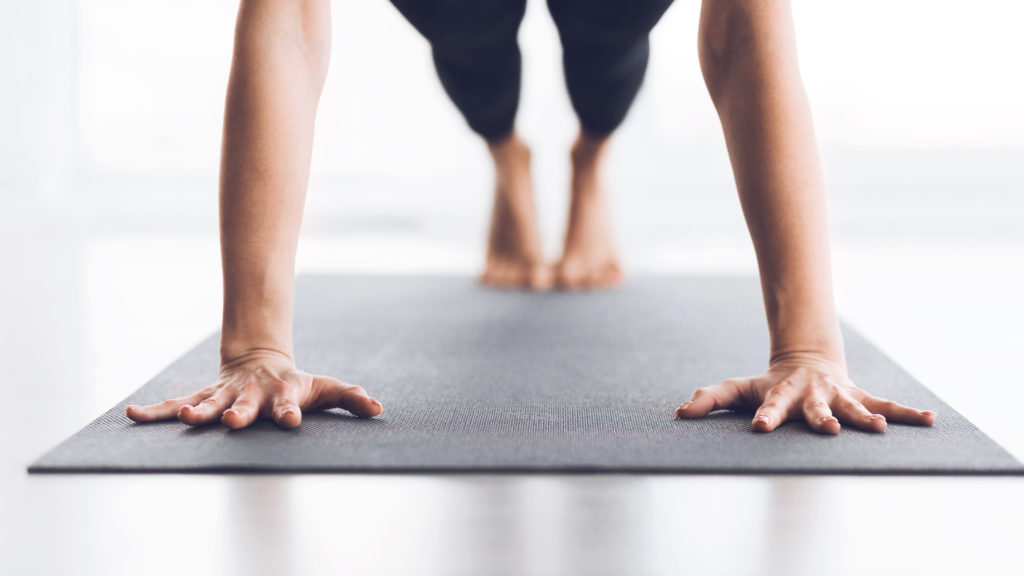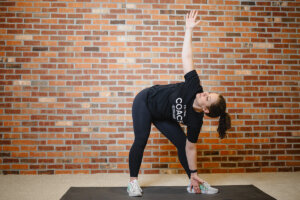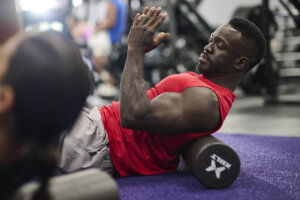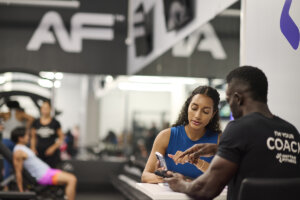Although yoga came to the west in the late 1800’s, and enjoyed a surge of popularity around the 1960s, it wasn’t until the 1990s that yoga staked its claim among the mainstream fitness crowd. But even though these days you can find some kind of yoga practice in just about every gym, park, and home in the United States, some people are still reluctant to try it. So, we thought it might be helpful to share some very accessible, basic yoga poses to help you become one with your mat and gain some of the benefits a yoga practice can provide.
First, a Little Pep Talk
Honestly. Truly. Yoga is for EVERYONE. So, if something in your mind is holding you back, let’s check in about that. Feeling shy about how you’d stick out in a class of devotees? Worried your friends will point and laugh? Think you need at least one Sanskrit tattoo? Not true!
First of all, you may not be as new to yoga as you think. Ever worked your core by doing a plank pose at the gym? Well, plank pose is a yoga pose, so you already have some experience under your belt. Fist bump!
And even if you’d never done plank pose, or any yoga pose, yoga is all about focus (and a little flexibility) so everyone in yoga class will be too busy concentrating on their own yoga practice to worry about yours, including your friends. And while there might be a lot of students rocking body art on the floor, they are part of a whole mix of yogis from all walks of life.
Besides, a big part of yoga is the philosophy, which includes non-judgement. Yoga sequences are a safe place to explore your body and build mind and body awareness. Sometimes the most important aspect of a fitness program is learning how to make it yours. That’s how yoga can be a great complement to your personal routine.
The concerns we hear most often are, “I’m not flexible,” or, “I’ll feel out of place,” and “I’m not good at yoga.” We can probably all admit we’re not good at lots of things when we’re just getting started. But it’s a good idea to keep trying. Yoga is a practice (with myriad benefits) It’s not a box score. So go ahead, throw on some comfortable clothes, hit the floor, and let’s get down with some basic yoga moves!
But first, let’s take a moment to… breathe.
Many “Yoga for ——-” articles jump right into beginner yoga poses, or easy yoga poses, or the best yoga poses, and miss the most important part of yoga: the breath. So let’s prep you with the life force behind all yoga poses, and the piece with the most benefits for the entire body, breathing. Sit up tall with good posture (shoulders back, spine elongated, head looking straight ahead) on the floor, kneel, or lie on your back—whatever is most comfortable for you. Take a deep breath in through your nose, filling your lungs with air in all directions – rib cage, chest, shoulder blades, belly, back. Exhale through your nose, letting your belly contract, and rib cage knit together. Maybe place your right hand over your heart and your left hand on your stomach and watch them move as you fill up with another deep breath and slowly let that deep breath out, making an oceanic sound as you do. Stay here for a few minutes. This is known as ujjayi pranayama.
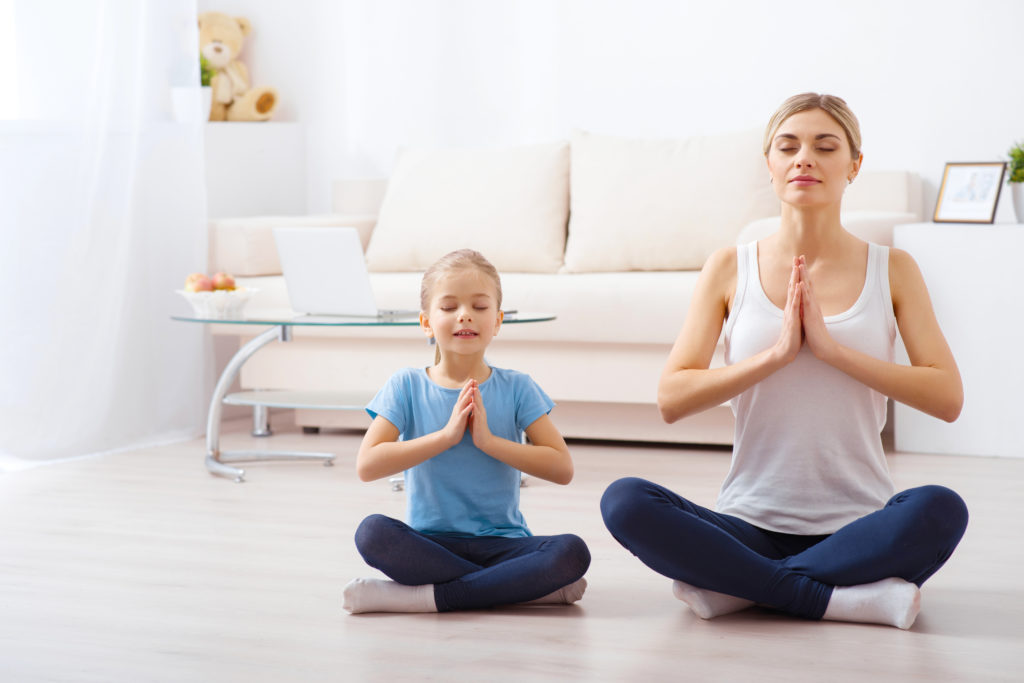
Easy Pose (Sukhasana)
If you’re new to the world of yoga, this pose is the perfect place to start—although don’t let the name fool you! If you’re not used to sitting upright with good posture on the ground with your legs crossed, you’ll be surprised with how much hip flexibility and back strength is required to last even a few minutes. If you find that your hips or leg muscles are tight, try sitting on a block, pillow, or blanket to help. Cross your legs, with your feet and pinky toes resting gently on the ground. Roll your shoulders back and raise your chest to the sky, stretching out your torso and lengthening your spine. Bring each arm out in front of your chest and press your palms together so that your elbows are point down towards the ground. This placement is known as “heart center.” Once in a comfortable position, focus on the rhythm of your breath, breathing in and out with control.
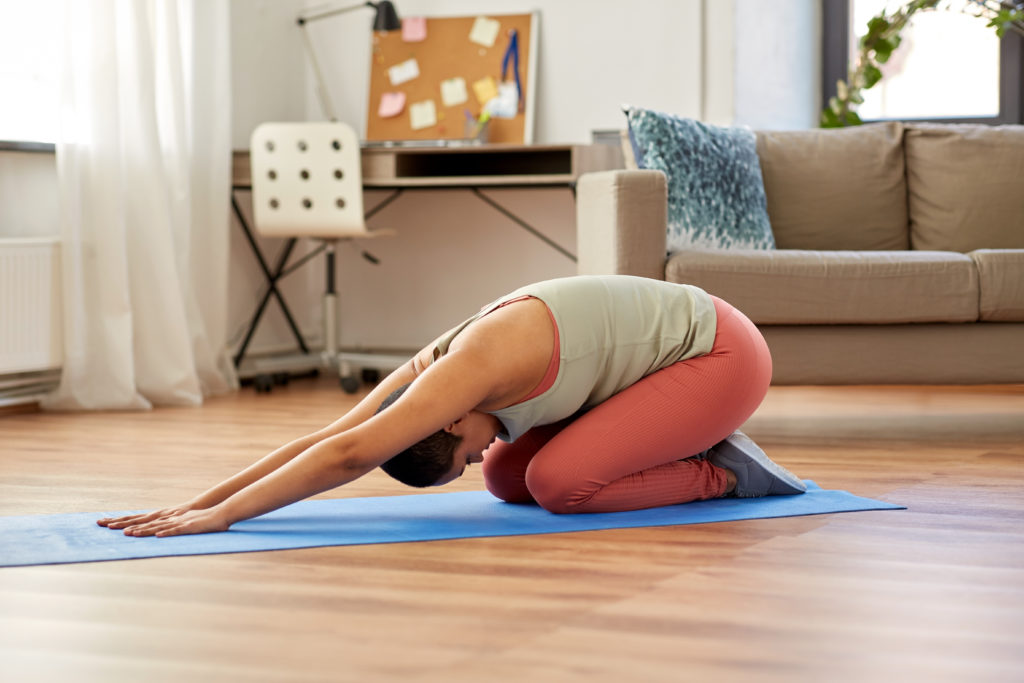
Child’s Pose
As easy yoga poses go, this is a winner that no yoga practice would be complete without. From a tabletop position (on your hands and knees), bring your feet and big toes together, let your knees open toward the edges of your yoga mat. Guide your hips back and down on top of your heels. Stretch your spine and extend each arm out in front of you, pressing your palms and fingertips into the ground. You will now be in a forward bend with your upper body and torso over your lower body, your knees near your armpits, and your glutes resting on your heels. Let your forehead connect to your mat on the floor with arms extended or let each arm rest along the side of your body. You may close your eyes. If you have low back pain, bring your knees closer together on the floor. This is your “home base” pose. During most yoga classes, your yoga instructor will invite you to come back down to the floor to child’s pose anytime you need a break, which is a very good idea. It’s a great place to reconnect to your breath and a great way to reboot…especially for beginners. The restorative benefits of this, one of the best resting poses ever, is incredible, and offers a gentle stretch for muscles in your low back, hips, thighs and knees.
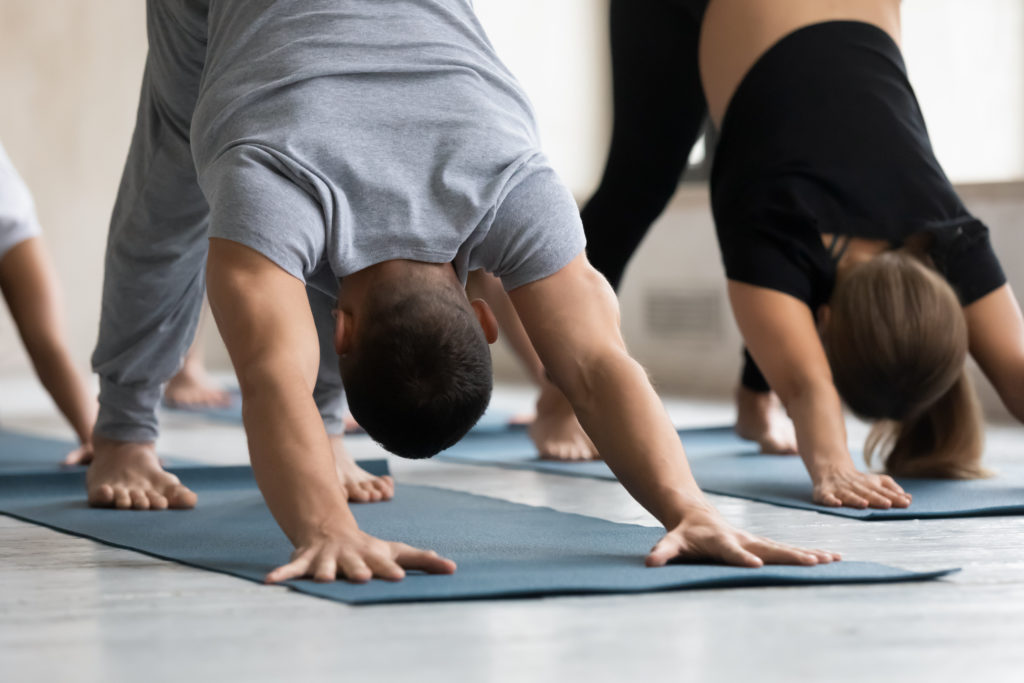
Downward Facing Dog
This easy pose is the upside-down “V” position you often see. From a table top position, place hands at shoulder-width distance, and knees and feet hip-width distance apart. Tuck your toes under, lift hips high and reach heels low (heels don’t need to touch the floor). You will now be in a forward bend position with hands and feet touching the floor. Soften your knees. Reach your chest toward your thighs and relax your neck and head. Pull your shoulders away from your ears. Focus on your spine feeling long. Inhale hips high, exhale heels toward the floor, reach low. Alternate bending your left and right knee and pedal out your feet a few times if you’d like. Breathe in and out through your nose. Try to evenly distribute your body weight, from your feet to your hands so you don’t stress your wrists. This stretches your calves, hamstrings, hands and arches. It even helps you relax. If you find it difficult to keep your legs straight in this position, try placing a yoga block under each hand to help.
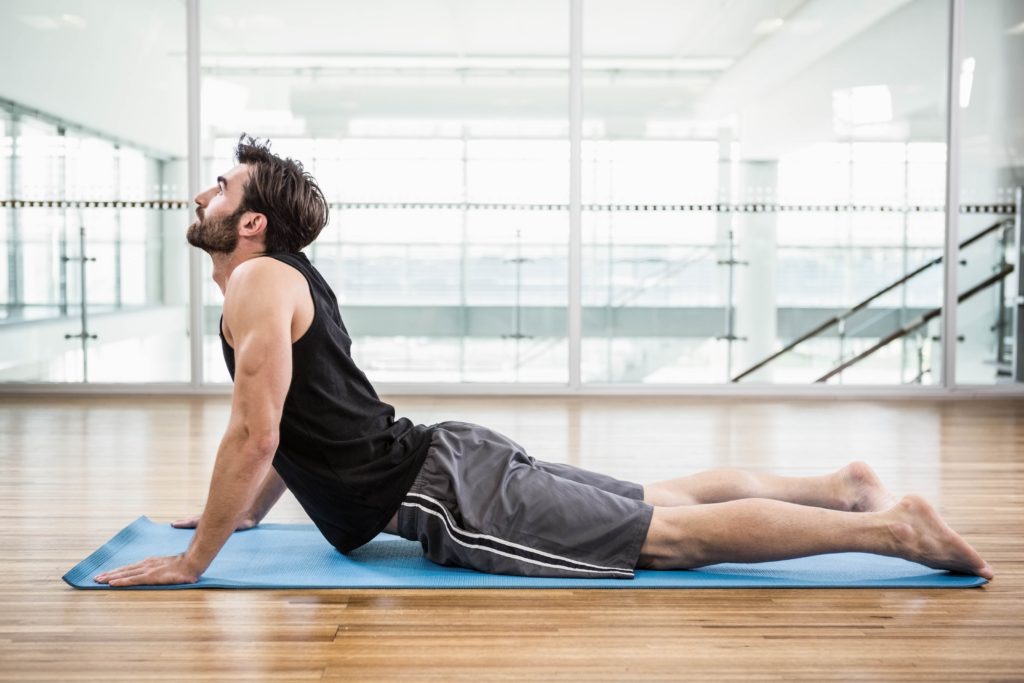
Cobra
Easy yoga poses don’t get much easier than this. Lay on your stomach, with your chin up. Place hands on your mat below your shoulders, with elbows pointing straight up to the sky. Zip your legs and inner thighs together. Press into the tops of your feet as you engage your abs to peel your chest and chin off your mat. You should have little or no weight in your hands. Think about reaching your chest and torso forward to help you lift. Only lift as high as feels comfortable. This stretches and strengthens your low back as well as firms your glutes. Cobra is a great alternative to the Upward Facing Dog pose as you work to build strength. Never feel shy to take this alternative, and ask an instructor about working with it.
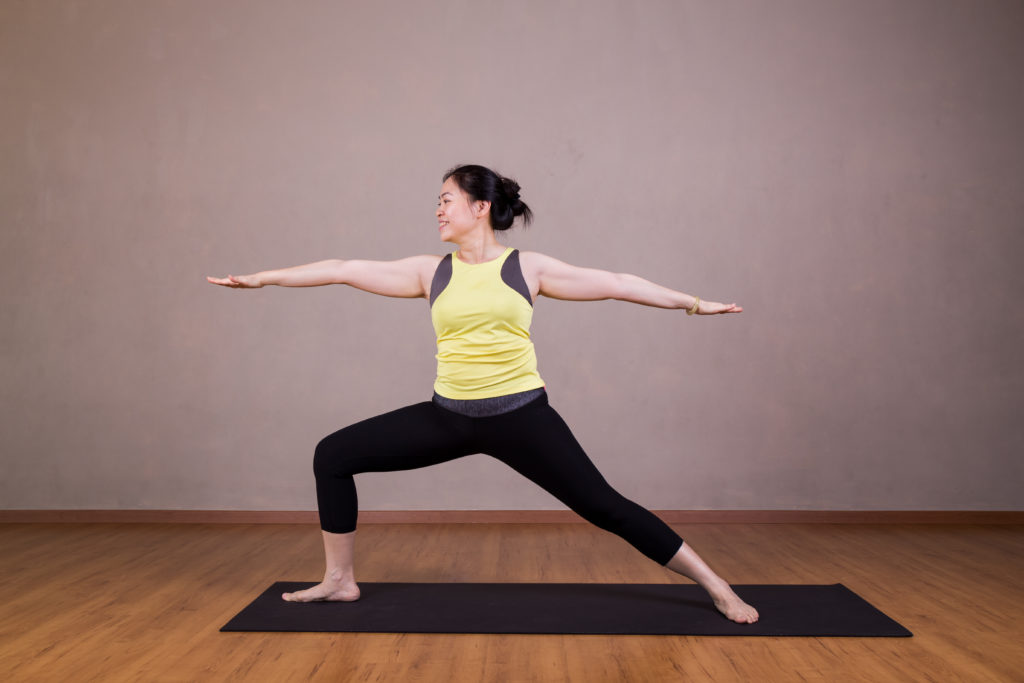
Warrior 2
This is one of our two standing poses, and while it’s not one of the advanced poses, there’s a lot to this one. Stand at the top of your yoga mat. Step your left foot back on the floor into a lunge position, keeping your right foot in place, pointing forward, and your right knee over your right ankle. Spin your left heel down on the floor (toes go diagonally) at a 45-degree angle. Rotate your right hip to the left, opening your pelvis to the side. Your right heel is in line with your left arch. Open your arms straight out at shoulder height, and parallel to the floor, palms face down, and shoulders relaxed. Gaze over your right hand. Hold and breathe. Step back to the top of your mat when ready. Repeat on the other side. The most common of warrior poses, Warrior 2 is the foundation of many yoga sequences. As you’ll feel, this pose will stretch your groin and thigh area and open your chest and lungs.
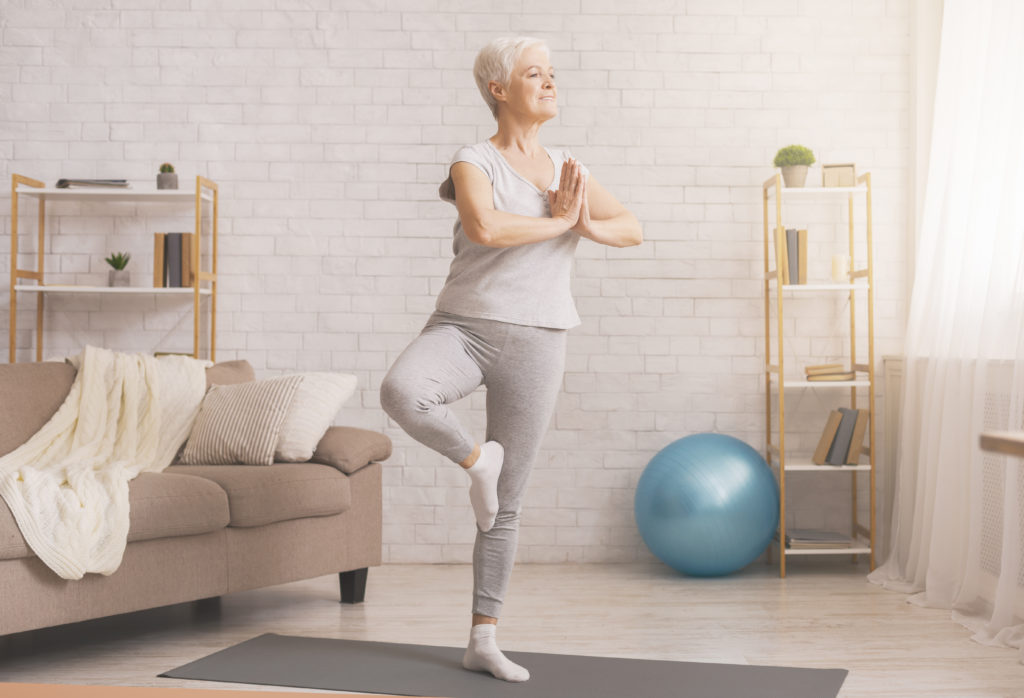
Bonus: Tree Pose
Our final of the standing poses is tree pose, which is a progression on from mountain pose. It’s also a beginning balance pose (but not an easy pose!) that provides a nice foundation before moving on to other balance postures. Start in mountain pose (mountain pose is a staple yoga position where you stand, feet together on the floor, with your arms above your head, directly over your shoulders.) Bring your palms down to face each other at your heart in a prayer position. Firmly root through your right foot into the ground and stand tall. Bend your left knee forward and then out to the side. Your left thigh will reach toward the ceiling. Take the sole of your left foot to the inside of your calf or help lift it up (by grasping your ankle with your hand) to your inner thigh. Your foot should never press directly into your knee joint. The sole of your foot is above or below your knee. Use the force of your inner thigh and your sole pressing together to stand a little taller, rooting through your standing leg. You should feel as if someone is pulling a string from the floor, through your right foot, then your thigh, up your spine and out over the top of your head. You could place your right hand over your heart and your left hand over that, if you’d like to try and center your energy there, or you can extend your arms upward, or move into reverse namaskar with your hands in prayer position behind you between your shoulder blades. The most important part of balancing is remembering to breathe! (Even if you crumble to the floor.) The benefits of Tree Pose are improved balance and strengthening your legs.
We could go over dozens of other beginner poses, like cow pose, which is an excellent part of any warmup and also a great pose to stretch your ab muscles after a core workout, padangusthasana where you extend your right or left thigh straight out in front of you while keeping the opposite foot on the floor, which is another balancing pose that really strengthens your hip flexors, shavasana, the pose everyone looks forward to because you lie flat on your back and chill at the end of class, and full yoga workouts to strengthen your upper body, lower body, entire body! But these are a nice place to begin because they are the foundation of more poses and sequences.
NOTE: Sometimes it can be challenging to hold yoga poses for the amount of time designated by your yoga instructor. (And that goes for beginners as well as experts.) Just remember to maintain a steady breath, and if you wobble, try again.
Just showing up for class is enough some days, so get yourself to yoga and nama-slay!
